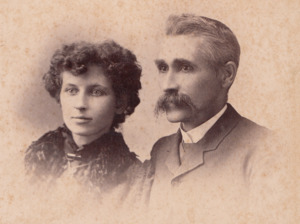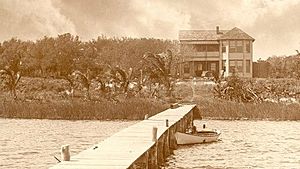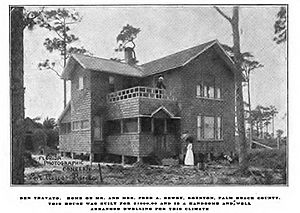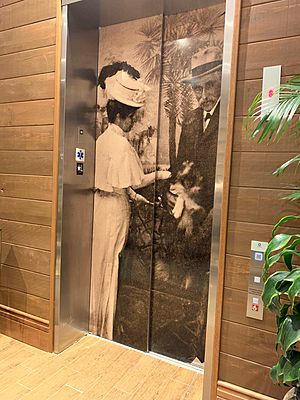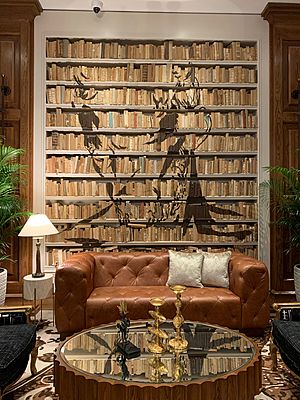Byrd Spilman Dewey facts for kids
Quick facts for kids
Byrd Spilman Dewey
|
|
|---|---|
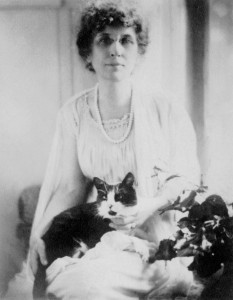
Byrd Spilman Dewey, 1918
|
|
| Born | Julia Bird Spilman February 16, 1856 Covington, Kentucky, U.S. |
| Died | April 1, 1942 (aged 86) Jacksonville, Florida, U.S. |
| Resting place | Greenlawn Cemetery |
| Pen name | Aunt Judith Sunshine, Judith Sunshine, Aunt Judith, Judith Ray |
| Occupation | Writer |
| Language | English |
| Nationality | American |
| Alma mater | Sayre Institute |
| Period | 1887–1927 |
| Genre | Fiction, animal stories, Florida pioneer |
| Notable works | Bruno, 1899 |
| Spouse | Fred S. Dewey |
Byrd "Birdie" Spilman Dewey (born Julia Bird Spilman; February 16, 1856 – April 1, 1942) was an American author and land investor. She also helped develop the Town of Boynton in Florida. She lived in Florida from 1881 until she passed away in 1942.
Her most famous book, Bruno, tells the story of the Dewey family's early days as pioneers in central Florida. This book was popular for over twenty years. It was first called "juvenile literature," but today it's more like young adult literature.
Byrd Spilman Dewey was very important in the history of pioneer South Florida. She was also known for her philanthropy (giving to good causes) and for protecting the environment. She worked with the Florida Audubon Society. She was even a finalist for the Florida Women's Hall of Fame in 2013 and 2017.
Contents
Early Life and Education
Byrd Spilman Dewey was born Julia Bird Spilman in Covington, Kentucky. Her parents were Jonathan Edwards Spilman and Eliza Sarah Taylor. Her great-grandfather was Colonel Richard Taylor, who was the father of President Zachary Taylor.
Byrd's father was a lawyer, a composer, and a Presbyterian minister. He wrote a famous song from the 1800s called "Flow Gently Sweet Afton". Sadly, her mother died on August 10, 1866, in a steamboat fire on the Bostona No. 3 in Maysville, Kentucky.
Byrd went to school in Kentucky, including Maysville College and the Sayre Institute (Sayre School). She studied literature, music, art, and languages. In 1877, she moved with her family to Salem, Illinois. There, she met Frederick Sidney Dewey, and they got married on September 25, 1877. Fred was a distant cousin of Admiral George Dewey and also of Melvil Dewey, who created the Dewey Decimal System.
Moving to Florida
Fred S. Dewey had breathing problems from his time serving in the American Civil War. Because of this, the Deweys moved to Florida in 1881. They first arrived in Jacksonville and looked at land near St. Augustine.
They bought 20 acres (81,000 m2) of land in Zellwood. They planned to grow vegetables and an orange grove. But by 1883, the land wasn't good for vegetables, and the orange trees needed many years to grow. So, the Deweys sold the land and moved to Eustis. Fred worked there as a bookkeeper.
Life in Eustis wasn't what they wanted. They moved back to Jacksonville, where Fred worked for a lumber company. In 1885, Byrd Spilman Dewey had their only child, Elizabeth, who sadly died as a baby.
In 1887, the Deweys heard about new land opening up in the south, near Lake Worth. This area was just starting to be settled. The Deweys claimed 76 acres (310,000 m2) of land about a mile west of Lake Worth, on Lake Mangonia. They grew coconuts, tamarind, pineapple, avocado, sugar apple, and guava. Fred would sail across Lake Worth every day to the small town of Palm Beach to work as a bookkeeper or carpenter.
Becoming a Writer
Byrd Spilman Dewey's first known writings appeared in the Florida Farmer and Fruit Grower newspaper in 1887. She wrote for a column called "Our Home Circle" using the pen name Aunt Judith Sunshine. She shared recipes and tips for living in the tough South Florida environment.
In 1887, she published her first article in a national magazine, Christian Union, called "On Toast." She wrote more articles for them, all under the name Judith Sunshine. From 1889 to 1895, she published many short stories in Good Housekeeping magazine. These stories were often about home life and good values.
In 1891, Dewey became the first columnist for Guy Metcalf's newspaper, The Tropical Sun. Her weekly column, "The Sitting Room," ran from April to September 1891. She signed her columns "Aunt Judith." She also wrote poems, short stories, advice, and recipes using the initials J. S. Her column offered advice on housekeeping, thoughts on family life, and recipes for tropical homes. In 1896, she published her first work under her own name in the Lake Worth Historian.
Her most important book, Bruno, was published in 1899. It sold very well across the country, with over 100,000 copies sold in its first year! It was even used as a reader in many schools. The book was like her autobiography, with Mrs. Dewey as the character "Judith" and her husband as "Julius." A biography of the Deweys in 2012, Pioneering Palm Beach, confirmed that Bruno was based on their real lives.
Her second book, The Blessed Isle and its Happy Families, came out in 1907. This book told stories about the cats and dogs that lived in the Dewey home in West Palm Beach. These stories started as articles she wrote for Vogue magazine. The stories took place at Ben Trovato, which was the Dewey family home on Lake Worth. They had moved there after selling their land on Lake Mangonia.
Her third book, From Pine Woods to Palm Groves, was published in parts in The Florida Review in 1909. This book describes the Deweys' adventures in the early days of Palm Beach County, from 1887 to 1893. Their home, Ben Trovato, was a popular spot for important people, including Henry Phipps and Mr. and Mrs. Woodrow Wilson.
Some of Dewey's recipes were even included in a 1913 cookbook called Economy Administration. This cookbook was supported by the White House during the Wilson Administration. She continued to write short stories, often publishing them herself in small booklets. Her last published work during her lifetime was in The Florida Naturalist in 1927, called "Some Bird Notes." In 2014, all of her known works were put together into one book: The Collected Works of Byrd Spilman Dewey.
Founding of Boynton
As Byrd Dewey earned more money from her writing, she started to invest in land in the fast-growing South Florida area. In 1892, she bought 160 acres (0.65 km2) of land at the south end of Lake Worth for $700.
In 1895, William S. Linton, a congressman from Michigan, offered her $6,000 for her land. Linton had visited South Florida with Nathan Boynton. Linton made a deal with the Deweys to pay them $1,500 a year for four years. But in 1897, Linton ran out of money. The Deweys sued Linton and Boynton. The case was settled, and the Deweys got their land back. Their role in founding Boynton was even shown in a documentary called Solving the Mystery of Birdie S. Dewey.
Nathan Boynton is often called the city's founding father, even though he never owned the town's land. When William S. Linton couldn't pay, he had already sold farm plots and town lots. The deeds he gave to settlers were worthless. After the lawsuit was settled in 1897, the money Linton had collected went to the Deweys, and they issued the proper deeds.
William S. Linton had not officially registered the plan for the town of Boynton. So, Frederick S. Dewey and Byrd Spilman Dewey officially registered the plan for the Town of Boynton in the Dade County courthouse on September 26, 1898. They also registered a plan for "Dewey's Subdivision," which had farming areas.
The Deweys built their first house in Boynton, called Spilman Cottage, and used it as a weekend home. Next to it, Fred Dewey planted the first orange grove in Boynton. The Deweys also donated land for a Methodist church. They used money from lot sales to pave streets. Mrs. Dewey even gave a large part of her personal library to start the town's first library, with the books kept at the local post office. The Deweys built a second home in Boynton, called Ben Trovato, where they lived from 1909 to 1911.
Protecting Nature
After her husband died in 1919, Byrd Dewey started working with the Florida Audubon Society. In 1920, she became the field secretary. This meant she traveled around the state giving speeches and presentations. She spoke about protecting nature, caring for animals, and creating safe places for birds. She continued this important work until she moved to Jacksonville in 1928.
Hotel Inspiration
On February 13, 2020, a hotel called The Ben opened on the West Palm Beach waterfront. This 208-room hotel was inspired by Byrd Spilman Dewey's welcoming home, Ben Trovato. You can see Dewey's silhouette (her outline) in the hotel's artwork, painted on the spines of old books. Her portrait is also featured on the hotel's special elevator that goes to the top floor restaurant, bar, and pool area.
Death and Legacy
Byrd Spilman Dewey passed away in 1942 in Jacksonville, Florida, after a long illness. She was buried in Greenlawn Cemetery in South Jacksonville. She didn't have many belongings when she died, but there was a long legal fight over her assets between her nieces and nephews and her caregiver. The case went to the Florida Supreme Court and was settled in 1944.
Honors
Byrd Spilman Dewey was a top 10 finalist for the Florida Woman's Hall of Fame in 2014 and 2017. The City of Boynton Beach also renamed a city park in honor of the Deweys.
Works
Books
- 1899 Bruno
- 1907 The Blessed Isle and its Happy Families
- 1909 From Pine Woods to Palm Groves
- 2014 The Collected Works of Byrd Spilman Dewey ISBN: 978-1494892333


